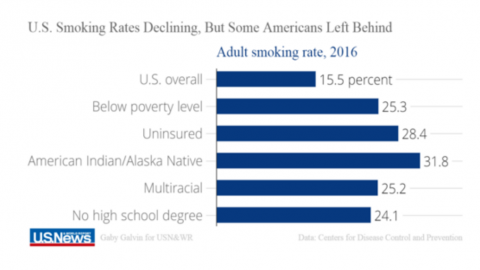Health Equity with Tobacco Control

Does tobacco advertising in stores target certain groups of people, such as youth, low income populations and racial/ethnic minorities? Of the Winooski and area residents who responded to this question in our 2018/2019 Winooski Tobacco and Alcohol Advertisement Opinions Survey, 43% strongly agreed with this sentiment while others varied between somewhat agreeing to having no opinion.
The truth is Big Tobacco does target certain populations with marketing and advertising, leading to health disparities among those populations.
If a health outcome is experienced greater or less between populations, there is disparity, according to the Office of Disease Prevention and Health Promotion. Race or ethnicity, gender, sexual identity, age, disability, socioeconomic status, and geographic location all contribute to an individual’s ability to achieve good health.
Michael Scott, the program manager at the National African American Tobacco Prevention Network (NAATPN), discussed in a training this month how Big Tobacco companies, especially those who produce menthol cigarettes, have targeted African Americans with its marketing, which has led to health disparities among this population.
Scott said prior to World War II and the Great Migration to the North, tobacco factories were the primary employer of African Americans. “The tobacco industry was the first major industry to provide free slaves, African Americans with jobs, with careers where they were able to support their families,” he said. “The tobacco industry was way ahead of its time in hiring black folks, putting them in management positions and kind of digging their way into the black community in the sense of being someone who supports the black community.”
Scott said early tobacco advertising was offensive to the African American community, but soon, the tobacco industry realized this population was an untapped market. The industry began targeting African Americans, “showing their support for the community” in their advertisements, which led to increased use of cigarettes among this population.
As a result of targeted marketing, menthol use among African Americans has skyrocketed over the last 50 years, with more than 88 percent of African American smokers smoking menthol cigarettes in 2016. In comparison, only 30 percent of white/non-Hispanic smokers smoked menthol cigarettes.

Why is menthol, an organic compound found in peppermint, a contributor to health disparities among African Americans? Research shows that smokers who use menthol tobacco products have a harder time quitting.
Tobacco use claims the lives of approximately 47,000 African Americans each year. “Close to 70 percent of the leading causes of death among African Americans can be related to tobacco use and smoking,” Scott said.
Scott said other ways Big Tobacco have targeted African Americans are through high-density advertising, promotions and discounts in their communities, vans handing out free samples, donations to African American elected officials, and sponsorships of community events.
Scott emphasized that African Americans aren’t the only population being targeted with marketing. “There’s a changing landscape of tobacco use,” he said, with more and more young people picking up e-cigarettes.
He said many young people, when they hear tobacco, they think of cigarettes, not JUUL or flavored tobacco products. In Vermont, 25% of youth who use tobacco believe flavored products are safer, according to CounterBalanceVT.
“We’re seeing the tobacco industry kind of focusing on that younger crowd, younger audience because what happens to their older customers? They’re dying because of the products,” Scott said. “So they have to continually recruit new smokers.”
So what can communities do to support health equity and combat the tactics of Big Tobacco companies? Communities can support reductions in point-of-sale advertisements, increases in taxes on tobacco products, expand smoke-free areas, and ban menthol and flavored tobacco products.
For more information and ways you can get involved, visit CounterBalanceVT.com. Want to quit tobacco or stay quit? Wherever you are on your path to quitting, help is here. Visit 802Quits.org.
Slides: Courtesy of Michael Scott of the National African American Tobacco Prevention Network
